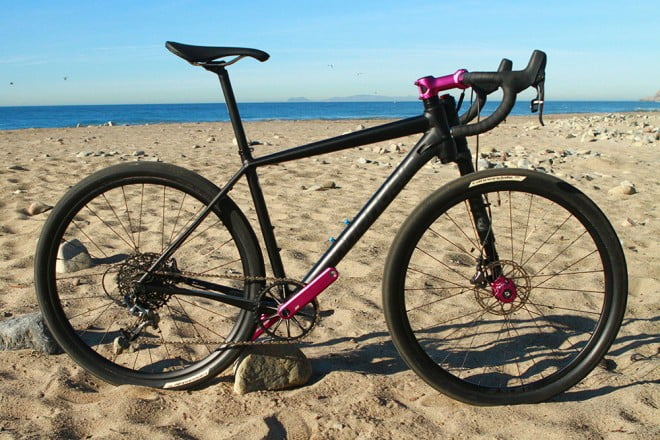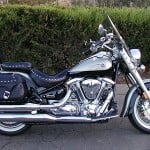
MALIBU, California — It’s exciting to ride what the pros ride, to throw a leg over a bike made to go as fast as possible. But realistically, that bike isn’t made for the everyday Joe who won’t toe the Tour start line anytime soon (or ever, actually). Cannondale believes that we will be much happier — and therefore more excited to get out for a ride — astride a versatile bicycle that’s not made for racing, but for everyday multi-surface conditions we face and sometimes seek out.
The Slate aims to deliver all that. But don’t mistake it for an old-man hybrid. The geometry is road-bike inspired, which means it’s low and long, though the chain stays are short at 405mm. In order to wed that short rear end with high-volume tires that make the bike trail-worthy, Cannondale downsized from 700c to 650b wheels that allow for bigger, higher-volume tires without lengthening the stays, while leaving the roll-out unaffected. The pairing of the 650b wheel with the 42mm wide, 300-gram tubeless slick tire — developed in conjunction with Panaracer — creates an identical roll-out to a 700x23c tire/wheel combo.
So essentially this is a road bike, but not exactly.
That’s a Lefty Oliver fork up front, sporting 30mm of travel and set up with a minimalist 2mm of sag. It sits at full ride height for absolute stiffness on the pavement, and since that travel comes from the stiff Lefty carbon chassis, what results is a suspension fork that doesn’t really act like one. Pop the button on the crown to unlock it and roll on the dirt, and you’ll get just enough compliance for comfort and control without all the bob and squish of a longer travel set-up.
Cannondale has long been an advocate of aluminum frames, and the company has stuck with metal for all Slate models. It dramatically flattened and shaped the chain stays and seat stays to offer compliance that combats aluminum’s harshness and stiffness to ensure power transfer when pushing hard. More lateral stability comes courtesy of the 142×12 rear axle spacing and the BB30A asymmetrical bottom bracket, which also allows for a wider chain stay spacing and, consequently, wider tires. The frame, which is the same for all build levels, weighs 1,200 grams (size large).
The top of-the-line SRAM Force 1 model offers a 1×11 drivetrain with a big 10-42 cassette mated to a 44-tooth chain ring on the Cannondale Si Hollowgram cranks.
First Ride
The canyons that twist inland from the Pacific Coast Highway boast sustained climbs, from leg-achingly steep to long and mellow. As we left the ocean behind, two things were immediately noticeable: The aluminum frame offers an exceptionally smooth ride, even more so than that of the CAAD12; and, the Slate climbs much better than expected. Not surprising, given that much of the frame design is trickle-down technology from Cannondale’s Evo and CAAD12 frames.
While the Slate stops just short of being peppy, it climbs reliably, and there was no noticeable flex. The wide tires do make some noise, but they didn’t feel sluggish. No, they’re not skinny road tires by any stretch, so it’s not reasonable to expect them to perform as such. The 42mm tires also offer plenty of traction over chattery roads, thanks to a wider contact patch. If you’re used to riding race bikes, be prepared for a bit of a learning curve, albeit a brief one.
Cannondale’s efforts to keep the chain stays short paid dividends on sweeping switchbacks leading back down into the valleys toward the ocean. Again, you’ll lose a few miles per hour to the tires, but the added traction in corners is worth the sacrifice. Because there’s more rubber to contend with, you’ll need to muscle the bars at high speeds. The trade-off is confident, stick-it cornering.
Off road, the Slate is an entirely different animal. Cannondale’s reps recommend 45psi as a compromise for on- and off-road performance; on pavement, the tire pressure feels just right. Off road, it helps to scrub 5psi. While the wide tires offer more traction off road — especially when tubeless — some sort of semi-slick knobby tires would be better in dry, marbly conditions. One minor over-correction in a corner and your front wheel washes out, putting you on the ground. The Slate makes trails a bit more challenging, and you can’t be lazy. If that doesn’t sound like your bag, keep an eye out for a savvy tire company to develop a semi-slick to suit your needs.
The Lefty soaks up enough chatter that you’ll be happy you’ve got that 30mm, but it’s by no means intended to take big hits. Mellow singletrack? The Slate is on board. But more-advanced trails could take the fun out of a bike like this.
By the end of the ride, it seemed entirely unnecessary to lock and unlock the fork since it’s so stiff. Even leaving it open on the road descents left enough stiffness for some impressive tracking through turns. Kudos to Cannondale for creating tailored suspension that makes sense for a part-time road, part-time dirt bike.
This of course begs the question: Why not just get a cyclocross bike? It’s a valid argument, and the easy answer is, you could. A ‘cross bike can handle on-road and off-road use, certainly. But the Slate pips a ‘cross bike in handling versatility: the wide tires do, indeed, make for more stable handling off-road and, quite frankly, more fun handling on-road. A cyclocross bike is likely designed for racing; the Slate is designed for enjoying.
Who is this bike for?
The separation between what the pros ride and what everyone else rides is becoming more vast, and that’s a good thing. It means more practical bikes for real riding we do. If you’re looking for a do-it-all bike, the Slate’s an option. But if you’re looking for a specific precision instrument for an application like cyclocross, or road riding, or mountain biking, there are better options for each category.
The Slate is designed for everyone, and no one in particular; it’s no beginner bike, but it’s a great bike for introductions to cycling both on and off road. It’s no race bike, but it’s got enough chops to go fast on the black top and the trail. And that’s the fun of it: The Slate encourages you to find yourself, especially if you know you’re not headed to the starting line. Murray Washburn, Cannondale’s global director of product marketing, said it best: “You can have a lot more fun in a lot more places with this bike.”
[“source-competitor”]





